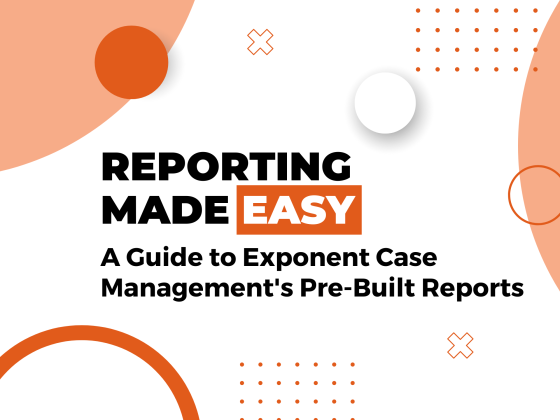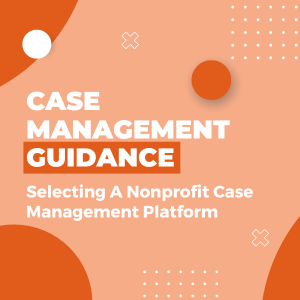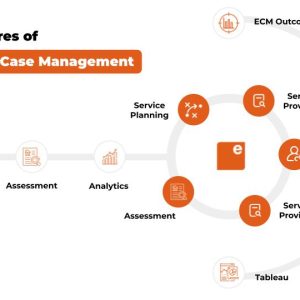Reporting Made Easy: A Guide to Exponent Case Management’s Pre-Built Reports
Exponent Case Management (ECM) is a powerful system specifically designed to support human services organizations in managing cases, programs, and outcomes effectively. With its comprehensive reporting functionality, ECM enables users to track and analyze key metrics and outcomes, supporting critical organizational processes such as measurement and evaluation, funder reporting, performance management, and outcomes monitoring.
While ECM makes it easy for users to create their own custom reports and dashboards, the system also includes 31 standard reports right out of the box. These pre-built reports cover a range of topics, from client demographics and program participation to outcome measures and evaluation results. The availability of these standard reports means that organizations can quickly and easily access critical information without needing to spend time building reports from scratch. Users can also use these reports as a starting point and customize them as needed to fit their specific needs.
ECM’s reporting capabilities enable users to monitor client progress, adapt services, and create dashboards for real-time tracking of client or program results. The system also allows for easy integration with advanced reporting business intelligence apps such as Tableau, Salesforce’s Einstein Analytics, and Microsoft Power BI.
ECM simplifies report and dashboard creation for funders or staff with simple drag-and-drop tools, enabling users to save report templates and develop versions of each dashboard by role, from Case Manager to Director of Monitoring and Evaluation.
In this blog post, we’ll provide an overview of the 31 standard reports available in ECM, including brief descriptions of each report, to help organizations get the most out of this powerful case management system.
- Assessment Summary by Program: This report provides a summary of all assessments taken by clients, grouped by program and type. This can help agency staff understand which programs are seeing the most assessments and what types of assessments are being used.
- ECM Assessment Responses: This report lists detailed responses for each assessment, which can be customized by adding assessment response fields. This can help agency staff understand individual client needs and track progress over time.
- ECM Assessments Taken by Program: This report provides a count of assessments administered, summarized by case record and program. This can help agency staff track the progress of assessments across programs and identify areas for improvement.
- ECM Assessments with Outcome Progress: This report summarizes assessments with outcome progress, grouped by case record. This can help agency staff monitor client progress and identify areas where additional support may be needed.
- ECM Individual Assessment Progress: This report tracks the progress of an individual’s assessment scores over time. This can help agency staff identify trends in client progress and adjust services as needed.
- ECM Case Load by Status: This report provides a count of case records, summarized by status. This can help agency staff understand the distribution of case records across statuses and identify areas where additional resources may be needed.
- ECM Case Load by Status and Program: This report provides a count of case records, summarized by status and program. This can help agency staff understand the distribution of case records across programs and identify areas where additional resources may be needed.
- ECM Incidents by Case Record: This report provides an incident matrix of case records by date of incident. This can help agency staff track incident patterns and identify areas for improvement.
- ECM Incidents by Program: This report provides a count of incidents, summarized by program. This can help agency staff understand the distribution of incidents across programs and identify areas where additional resources may be needed.
- ECM My Case Load by Status: This report provides a count of owned case records, summarized by status. This can help agency staff understand their own caseload and prioritize work accordingly.
- ECM – My Incidents by Case Record: This report lists incidents by case records by week. This can help agency staff understand patterns in incidents across clients and identify areas for improvement.
- ECM Program Case Load by Staff & Status: This report provides a count of program case records, summarized by staff and status. This can help agency staff understand the distribution of case records across staff and identify areas where additional resources may be needed.
- ECM Progress Notes List by Case Record: This report provides a list of progress notes, summarized by case record. This gives agency staff a complete history of a client’s progress notes in a program, helping staff track progress over time and adjust services as needed.
- ECM Client Contact Info List by Program: This report provides a list of client contact information, summarized by program. This can help agency staff ensure they have up-to-date contact information for clients and communicate effectively.
- ECM Household Mailing List by Program: This report provides a list of client household contact information, summarized by program. This can help agency staff ensure they have up-to-date contact information for households and communicate effectively.
- ECM Client Dem. Matrix – Gender by Race: This report provides an enrolled client’s matrix of gender by race/ethnicity, summarized by program. This can help agency staff understand the demographics of their clients and track progress in serving diverse populations.
- ECM Client Demographics – Gender: This report provides a count of enrolled clients, summarized by gender and program. This can help agency staff understand the demographics of their clients and track progress in serving diverse populations.
- The ECM Client Demographics – Race/Ethnicity: This report provides a count of enrolled clients, summarized by race/ethnicity and program. This report could be helpful for human services agency staff in several ways. It provides an overview of the racial and ethnic makeup of the agency’s client base across different programs, which can be useful for identifying disparities in access to services and designing outreach efforts to better reach underrepresented groups.
- ECM Enrollment – New Program Participants: This report can help agencies track the number of new program participants they are enrolling, and identify trends in enrollment over time. It can be useful for program managers who want to understand how well their programs are reaching new clients, as well as for grant writers who need to report on program participation rates.
- ECM New Client Enrollment by Program: Similar to the Enrollment report, this report provides information on the number of new clients enrolling in each program, broken down by intake date. This report can help program managers identify patterns in client enrollment and track how successful their outreach efforts are.
- ECM Participant Demographics Summary: This report summarizes participant ethnicity and race by program, providing an overview of the demographics of clients served by each program. It can help agencies identify disparities in service provision and target outreach efforts to underrepresented communities.
- ECM Program New Enrollment: This report provides an overview of new client enrollment to each program, broken down by intake date. It can help program managers track the success of their outreach efforts and identify areas where additional outreach may be needed.
- ECM Unduplicated Client Count: This report provides a count of the number of enrolled clients across all programs, accounting for duplicate clients who may be enrolled in multiple programs. It can help agencies understand the total number of clients they are serving and track changes in client enrollment over time.
- ECM Unduplicated Clients by Program: This report provides a count of the number of enrolled clients by program, accounting for duplicate clients who may be enrolled in multiple programs. It can help program managers understand the total number of clients they are serving and track changes in client enrollment over time.
- ECM Inbound Referrals by Status & Program: This report summarizes inbound client referrals by program and status, providing information on the number and status of clients referred to each program. It can help program managers track the success of their referral networks and identify areas where additional outreach may be needed.
- ECM Outbound Referrals by Status & Program: Similar to the Inbound Referrals report, this report summarizes outbound client referrals by program and status, providing information on the number and status of clients referred out of each program. It can help program managers track the success of their referral networks and identify areas where additional outreach may be needed.
- ECM Group Direct Service by Program: This report provides a summary of group direct services provided by program and group. It can help program managers track the success of their group programs and identify areas where additional support may be needed.
- ECM My Direct Services Rendered: This report provides a summary of the direct services provided by individual staff members. It can help supervisors track the work of their staff and identify areas where additional support may be needed.
- ECM My Staff Units of Service: This report provides a summary of the service units provided by individual staff members, broken down by case record. It can help supervisors track the productivity of their staff and identify areas where additional training or support may be needed.
- ECM Program Units of Service by Staff: This report summarizes the service units provided by staff members for each program. It can help program managers understand the productivity of their staff and identify areas where additional support or training may be needed.
- ECM Staff Units of Service by Program: This report summarizes the service units provided by staff members for each program. It can help program managers understand the productivity of their staff and identify areas where additional support or training may be needed.
If you’re looking to streamline your case management processes and improve outcomes, Exponent Case Management (ECM) is the perfect solution. With its comprehensive reporting functionality and 31 standard reports, ECM enables users to track and analyze key metrics and outcomes, supporting critical organizational processes such as measurement and evaluation, funder reporting, performance management, and outcomes monitoring. Whether you’re interested in tracking client demographics, program participation, or outcome measures, ECM has a report to help you. Don’t wait, start using ECM today and take your case management to the next level! Sign up for a live demo or contact us to learn more!




